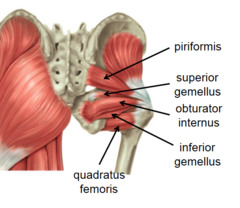Deep Buttock Pain: Causes and Treatment
For more muscle therapy articles, fitness and rehab news, follow us on Facebook.
It can be difficult to determine the cause and to treat deep gluteal pain. The piriformis muscle is often suspected, but rarely the source of the pain. The muscles below the piriformis often need treatment: superior gemellus, obturator internus, inferior gemellus , obturator externus and the quadratus femoris. A thorough differential diagnosis, Active Release Techniques (ART) and specially tailored exercises should be considered to help alleviate deep gluteal pain.
Patients with deep gluteal pain near the ischial tuberosity are often told they have a high hamstring issue. Often the hamstring is not involved, but the obturator internus or quadratus femoris is the source of the pain. A sac of fluid, called a bursa, lies under each muscle, and when they become inflamed they are called a bursitis. About 20 different bursae have been identified near the hip and pelvis(1), and should always be considered when doing rehabilitation exercises to help gluteal pain.
..the obturator internus tendon makes a right-angled bend over the grooved surface of the ischium, between the ischial spine and tuberosity, and then passes horizontally across the posterior to the hip joint before it inserts into the greater trochanter. Moreover, the obturator internus bursa is located between the obturator internus tendon and the grooved surface of the ischium(1) (anatomy video).
If bursitis is not the source of the pain, the muscles and tendons of the deep gluteal muscles should be treated with a soft tissue technique called ART. The tendons may have some inflammation (tendinitis) which causes a problem, although in many cases little inflammation is present (tendinopathy) is present. Tendinopathy can be treated with limited compression of a bursa, by avoiding compression of tendons where they pass over bones. Tendon loading is covered in this excellent video.
Another possible source of deep gluteal pain is pelvic floor muscle weakness, and in stubborn cases it probably is wise to rule it out.
Our approach:
1. Check hip range of motion.
2. Plank activations if ROM is decreased, if no change we use Soft Tissue Therapy of the deep gluteal muscles.
3. Give exercises to strengthen which ever muscle is weak, that don’t compress tendons and bursae.
4. Rule out pelvic floor issues and ischiofemoral impingement syndrome(2).
You may also like.
Obturator Internus, Quadratus Femoris and Bursae.
Articles we contributed to:
Telegraph The ART of Active Release Techniques for Injuries
STACK New Age of Golf Training is Creating Stronger and More Athletic Golfers
Athletics Weekly Performance Therapy for Greg Rutherford
220 Triathlon ART- How is it different from sports massage
FIT Institute Research based hamstring therapies
TPI What Performance Therapy Looks Like For Top Golfers
Podcasts I was on:

